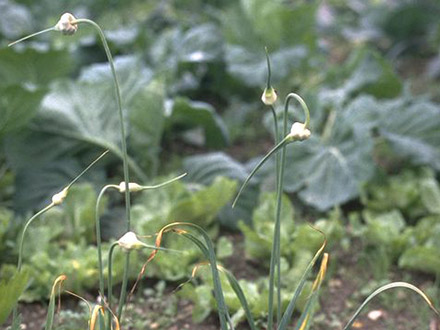Botanical name
Allium sativum L.
Family
Amaryllidaceae
Common name
Garlic, Camphor of the Poor, Poor Man’s Treacle, Rocambole, Rustic Treacle, Russian Penicillin
Information about the plant
Central Asia is the native region of garlic, but the plant has been cultivated for a very long time and is now grown almost worldwide, especially in the Middle East. The garlic used in Europe comes from crops in southern Europe.
Its long tradition as a cultivated plant is reflected in the species epithet sativum (Latin "sativus" = cultivated, planted, sown). The etymology of the genus name Allium is unclear; it may derive from the Latin "olere" (= to smell), referring to the distinctive odor of the Allium species such as garlic, onion, wild garlic, and chives. The German name “Knoblauch” is associated with the Old High German 'klobo' (= split stick, clove), meaning “split leek”. This refers to the garlic bulb composed of individual cloves.
Unlike the common onion (Allium cepa), garlic is not a bulb with nested leaves. Its tubular, separate, white leaves are arranged side by side around a compressed axis. Each leaf encloses 3 to 5 "cloves". This term is referred to the tightly packed, slightly angular, curved secondary bulbs that surround the elongated, ovoid main bulb on the hard bulb base covered with root fibers on the underside. The edible part of a clove consists of the fleshy lower leaf of the rhizome (underground shoot portion) that surrounds the bud in a tubular shape. This is accessed by removing the white and reddish papery husks of the clove. The main and secondary bulbs are also enclosed by several dry, whitish leaf sheaths, giving the appearance of a single bulb.
The plant is a perennial that grows 25 to 70 cm tall with an erect, rigid stem, leafy up to the middle with flat, broad-linear, pointed foliage. The flowers are borne on long stalks, but usually remain in the bud stage; the petals are reddish or greenish-white.
Medicinally used parts of plants (herbal drug)
The dried cloves are used in powdered form (garlic powder - Allii sativi bulbi pulvis).
Garlic is imported from the Mediterranean countries and from China.
Constituents of the herbal drug
Fresh garlic cloves contain odorless alliin [(+)-S-allyl-L-cysteine sulfoxide], which is converted into allicin (allyl-2-propenthiosulphate) when cut and dried through contact with the plant’s own enzyme, alliinase. This gives fresh garlic its characteristic pleasant smell, but allicin is then spontaneously converted into strong-smelling, volatile sulfur compounds. During the production of the drug, the alliin-alliinase system should remain as intact as possible, which is achieved through rapid and gentle drying of the bulb.
Quality of the drug
The quality of garlic powder (Allii sativi bulbi pulvis) is specified in the European Pharmacopoeia (Ph. Eur.), as is the quality of Allium sativum for homeopathic preparations.
Medical applications
Recognised medical use
The HMPC has classified garlic bulb as a traditional herbal medicinal product (see ‘Traditional use’).
ESCOP: Preventive against atherosclerosis, also for elevated blood lipid levels that cannot be adequately controlled by dietary measures. Supportive in cases of elevated blood pressure, infections, and catarrh of the upper respiratory tract.
Traditional use
The HMPC has classified garlic bulb as a traditional herbal medicinal product (Article 16a of Directive 2001/83/EC). Based upon long-standing use, garlic bulbs can be used to prevent atherosclerosis and to alleviate cold symptoms.
Herbal drug preparations in finished dosage forms
- Garlic bulb powder in capsules and tablets
- Garlic oil macerates in capsules
Dosage
Finished product: See patient information leaflet.
Fresh garlic bulb: Average daily dose 4 g. It is not advisable to prepare a tea, as alliin is barely soluble in water and therefore hardly transfers into the infusion; in addition, it would spontaneously transform into unpleasant-smelling sulfur compounds during preparation.
Preparation of a tea
Not applicable.
Notes
Consumption of garlic and garlic preparations can cause changes in body and breath odor.
There is no evidence of risks during pregnancy and lactation. Garlic substances are excreted into breast milk. Arteriosclerosis is not a relevant indication in children and adolescents.
Side effects
Rarely, gastrointestinal complaints or allergic reactions.
Interactions
There are no fully established data on a possible strengthening effect when taken concomitantly with anticoagulants (Marcurmar etc.) or blood pressure-lowering drugs. Also, there is no clear evidence of a possible weakening effect on HIV protease inhibitors such as Saquinavir/Ritonavir.
References
Herbal drug monographs
HMPC (2020, 2021), ESCOP (2019), WHO (Vol. 1, NIS).
Further literature
Commentary on the European Pharmacopoeia (Garlic powder, No. 1216).


